
'Simple but not simplistic': On the road with the Eucharistic Revival's test pilgrims
Here's what to expect from the Eucharistic Revival's walking pilgrimages.
Editor’s note: This report was originally published June 13, 2023. We’re republishing it during the week of Christmas 2023, for your reading enjoyment!
On a June morning outside Albion, Indiana, a sporty blue Audi TT hit the brakes hard on a hilly country road, the car’s driver befuddled by a spectacle in the road’s shoulder.
With his car at a dead stop in the middle of the road, his foot still on the brake, the driver rolled down the window and called out: “What are you all doing? Is this some kinda parade?”
Here’s what he saw outside of his car: A line of pedestrians, walking alongside a newly planted cornfield. At the front was a young woman in a blue T-shirt, wearing a floppy-brimmed hat and consulting a map. Behind her, another young woman, carrying a large crucifix on a pole.
Behind them was a man in a white tunic — an alb — and a stole, who was carrying in front of him a large, golden statue of some kind, with a kind of a sunburst design.
That group was followed by a half dozen or so more — some young, some old — most carrying prayer beads, and reciting Hail Marys, one after another.
If the driver had looked closer, he would have seen in the center of the golden statue — formally called a monstrance — a small glass case, which appeared to contain a thin, white wafer of bread.
All this ceremony for that?
Apparently so.
The driver called out again:
“What are you all doing?”
Most of the crew kept walking. But one of the walkers, a young man in his early 20s, leaned into the car window:
“This is a Eucharistic pilgrimage.”
“What does that mean?”
“The Catholic Church has the Eucharist, which we believe is the body and blood of Jesus.”
The driver frowned and chewed his lip. It wasn’t clear how much all that meant to him. But the next bit impressed him enough:
“We’re walking from Fort Wayne to South Bend. It’ll take a couple of days more, and while we walk we pr—”
The driver cut him off.
“South Bend! Geez! That’s far! Good luck!”
The window rolled up, and the Audi sped off. The walkers continued on their trek, finishing the sorrowful mysteries of the rosary, before offering a litany of the saints.
—
On that Indiana road outside Albion, the Catholics walking up and down hills were the first Eucharistic pilgrims of the National Eucharistic Congress, which will be held next July in Indianapolis, as a countrywide gathering of Catholics, convened to adore Christ in the Blessed Sacrament.
The Congress will be preceded next year by four walking Eucharistic pilgrimages, in which teams of 12 young people — with a priest — will traverse the country, from the East Coast, the Bay Area, the headwaters of the Mississippi, and the southern tip of Texas, along the country’s border with Mexico.
Walking for weeks — and carrying the Eucharist across the country — those teams will converge in Indianapolis ahead of the July 17 Eucharistic Congress in Lucas Oil Stadium.
Along the way, teams will be housed and fed by local parishes and host families, and Catholics from across the country will be invited to walk alongside them.
Planning the Eucharistic pilgrimages is a massive undertaking, mostly coordinated by the staff at Modern Catholic Pilgrim — a non-profit pilgrimage apostolate with the contract for arranging those 2024 Eucharistic pilgrimages. The group is already arranging housing and volunteers, and securing permits for solemn processions in the larger cities through which they’ll pass.
But a pilgrimage can’t be planned without on-the-ground experience, staff members at Modern Catholic Pilgrim told The Pillar — especially since Eucharistic pilgrimages, traveling with the Blessed Sacrament, are somewhat rare, and require a lot of forethought.
So to get a sense of how things will go, planners started working last October with the Diocese of Fort Wayne-South Bend, Indiana, to plan a 2023 walking Eucharistic pilgrimage for Fort Wayne, in the diocese’s southeast, to South Bend, in its northwest.
The walk would be kind of a tune-up for the 2024 pilgrimages — a proof of concept, really — and it would give pilgrims a chance to start praying for those 2024 walks, organizers figured.
And, according to Will Peterson, Modern Catholic Pilgrim’s executive director, the team learned a lot in their eight-day trek across a sliver of Indiana.
—
The group’s plan to walk from Fort Wayne to South Bend was simple.
Each day, beginning June 4, they’d walk from parish to parish across the diocese, ending at St. Matthew’s co-Cathedral on June 11.
In total, the route would be about 100 miles, an average of 12 or so miles for each of their eight days. Each evening they’d have adoration or evening prayer in a parish church, and then be hosted by local families.
The team for that Indiana pilgrimage would be led by Peterson, 31, of Modern Catholic Pilgrim.
With him would be four other “perpetual pilgrims,” making up a kind of core team: John Donahue, a documentary filmmaker from Florida; Lauren Rivera, an undergraduate at Notre Dame; Bridget Breckler, who plans to enter a Carmelite monastery in the fall, and Fr. Stephen Felicichia, a Fort Wayne-South Bend priest ordained three years ago — who had special care of the Eucharist as the group made their trek.
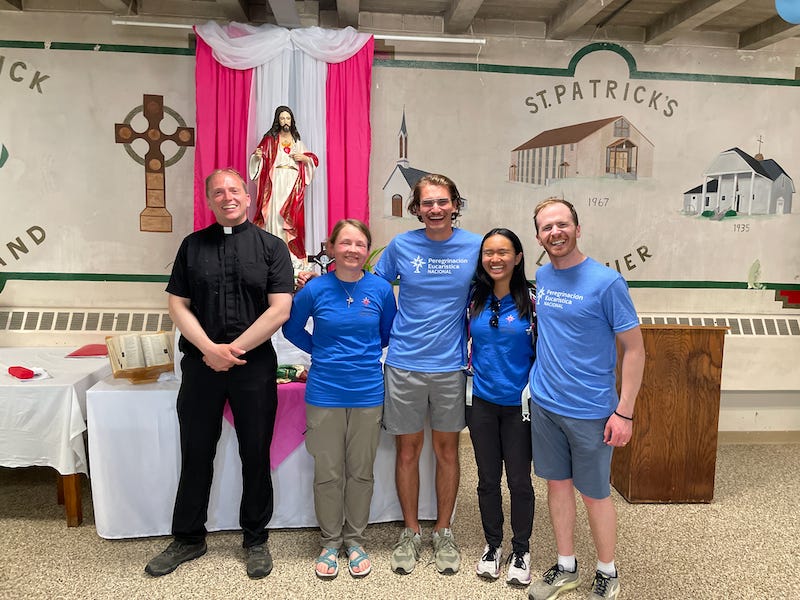
As the group walked, they’d be followed by a support vehicle, driven either by Peterson or a parish volunteer.
Local Catholics would join them each morning for Mass, followed on most days by a one-mile solemn procession, with a canopy, altar servers, and incense. The solemn processions would walk through small towns — sometimes with police escorts — and end on courthouse lawns or in park pavilions, where parishioners had set up small altars for a few minutes of adoration.
After those solemn processions, and after a Eucharistic benediction at the terminus, the servers and most of the parishioners would disperse, heading for coffee or breakfast at small-town diners.
But the perpetual pilgrims would put on more sunscreen and have some water, and the group would set out on a “simple procession,” walking with a map reader and a crucifix-bearer at the fore, Fr. Felicichia carrying the monstrance, and the rest of the team walking behind, along with the locals who had decided to accompany them for more miles that day.
As they walked, the team would pray the rosary — 20 decades daily — along with Divine Mercy chaplets, and other pious devotions. They’d sing Marian songs and ancient Eucharistic hymns.
Further back from the monstrance, pilgrims and local Catholics would chat a bit, sometimes casually, and sometimes in deep spiritual conversation.
And at times a silence would seem to fall over the whole group. They’d walk quietly, listening to the buzzing of insects, and the drone of crop-spraying airplanes overhead.
In front yards or on porches along the route, devout Catholics would drop to their knees as the Eucharist passed by — others along the road would stare slack-jawed, or start recording with their phones.
Sometimes a dog would follow for a few minutes, or a horse would trot alongside the walkers behind a pasture fence.
Only a few people would ask what the group was doing — far fewer than you’d expect, actually.
But when it would happen, one of the pilgrims would stop to chat, and then jog to catch up with the group. Except for lunch, the group would almost never stop walking, unless for a traffic light, or to cross a busy intersection.
—
While some days’ walks were 10 miles or fewer, others were more of a push, and on one, the team walked almost 20 miles from one parish to the next.
It isn’t easy to carry a gold-plated monstrance for even 10 miles each day.
But Fr. Felicichia, 37, explained to The Pillar that he had a few advantages:
First, his experience as a West Point grad, with two Army tours in Afghanistan, had gotten him accustomed to long walks with heavy equipment.
Second, the monstrance used by the team was lightweight.
Most important, though, is that Felicichia walked with a kind of custom harness over his alb, fitted with a pouch of sorts across his chest, into which the base of the monstrance could be fitted. That spread the weight of the monstrance from his arms to his back and chest — and the same kind of harness will be used by the priests accompanying each of the pilgrimage teams next year.
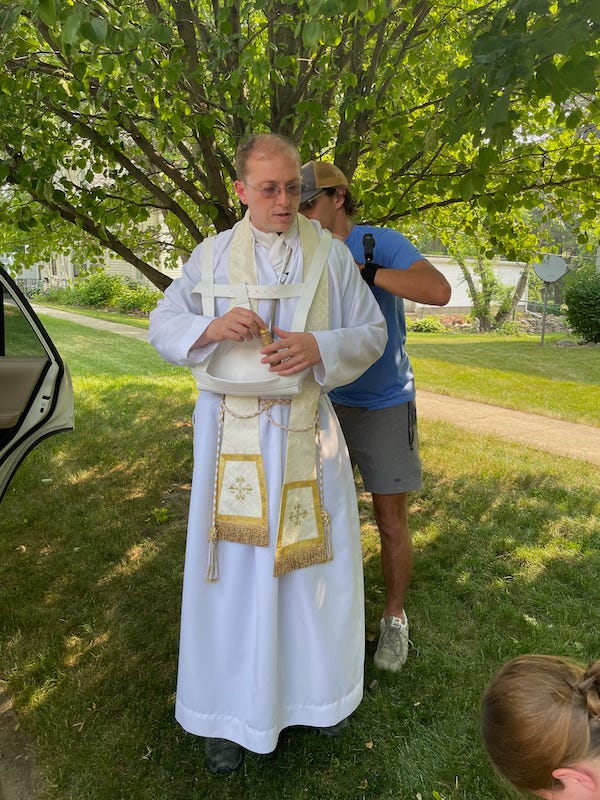
Peterson told The Pillar that the liturgical protocols for the “simple procession” were developed by a team of consultants for the Eucharistic Congress, and had gotten a sign-off from the liturgy office of the USCCB.
When the group did stop during the day — at lunch, or before the simple processions began — Felicichia said he’d been instructed to repose the Blessed Sacrament in a small wooden tabernacle affixed to the inside of the support SUV.
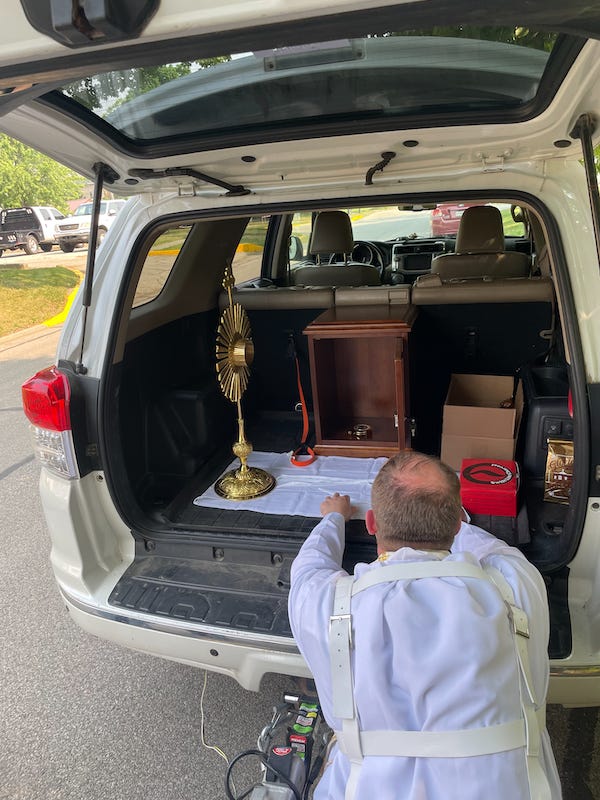
Felicichia would only repose the Eucharist in that tabernacle for short periods, the priest said.
When the Eucharist was in that temporary tabernacle, the priest never seemed to leave its side. When he needed to make a bathroom break, another perpetual pilgrim stayed with the Eucharist.
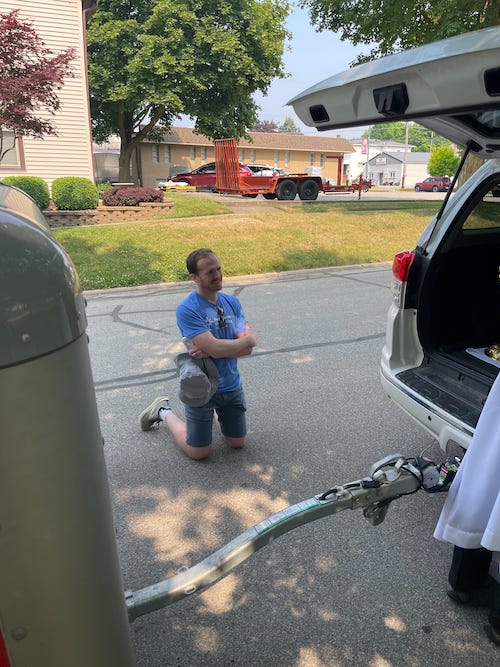
“We never leave the car alone if the Lord is here,” the priest told The Pillar. “Not ever.”
Each night he’d reserve the host in the tabernacle of the parish the pilgrimage team was visiting, Felicichia told The Pillar.
Felicichia said that while it took a bit of getting used to, he was comfortable with the liturgical protocols of the “simple procession,” which were specifically approved for the Indiana walk by his own Bishop Kevin Rhoades of Fort Wayne-South Bend.
The priest, with a military bearing his fellow pilgrims described as “hardcore,” told The Pillar that he believed planners had given careful consideration to the logistical prospects of traversing the country with the Blessed Sacrament.
“To the best of my ability, it is as reverent as you can make it. How reverent? Well, we’re walking on roads and adapting to things on the fly. And in that sense, it does remind me a lot of the Army. So you adapt — obviously, there are certain things you can’t do and certain things you can, because you’re carrying the God of the universe with you.”
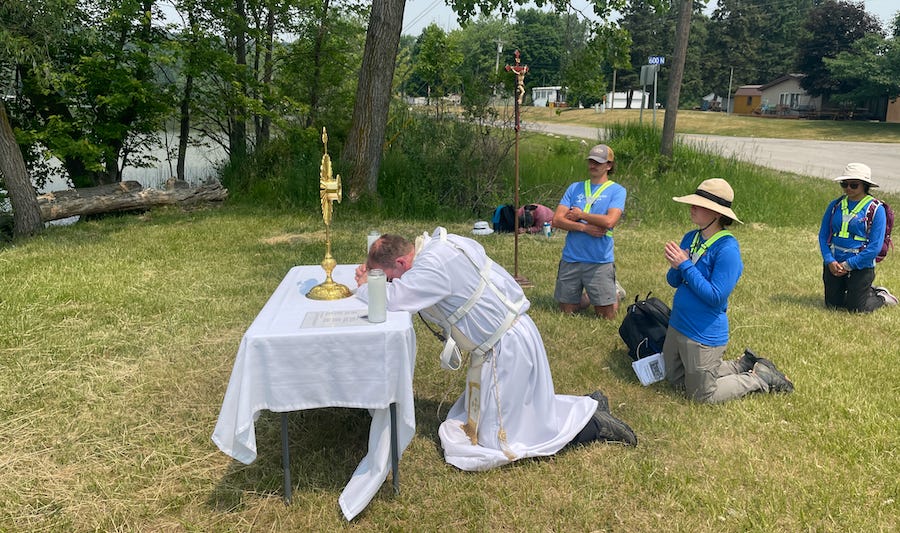
The priest said that at times, while carrying the monstrance, he’d been in uncomfortable situations — he’d tried to maintain a silent disposition, and someone had come up to him to chat, or he’d needed to apply more sunscreen to his head, as he was not willing to wear a hat while carrying the Blessed Sacrament.
“I have had moments of half-a-second of, like, ‘How should I handle this or that situation,’ and then you make a choice, and then you go with it. It’s all just prudence to the best of our ability,” the priest said.
“What is my goal here? My goal isn’t to offend the Lord, my goal is to maintain as much reverence as I can, and I’m doing the best I can with what I have,” he added.
“Really, It reminds me so much of the Army, where you get the orders, and they say, ‘We want this, make it happen,’ and you say, ‘Well, I presume I have some flex then as we go.’ So we’re flexing, as we figure out how to make a pilgrimage like this, with the Blessed Sacrament, really work.”
But while the plan was simple, there was still room for it to go awry. During their trek across Indiana, the pilgrims would deal with rain, with an allergic reaction to sunscreen, and with then a broken SUV, which left them scrambling one day for a spare support vehicle, eventually made available by an Albion, Indiana parishioner.

For Peterson, the organizer, that’s part of what it means to make a pilgrimage — having a clear sense of where you’re going, and trusting that God has a plan for how you’ll get there.
“You need to know where you’re going and what your intentions are,” Peterson told The Pillar, as he walked along a farm road on June 7.
“And if you really know that, and you’re holding those things, you’re making a pilgrimage.”
Peterson told The Pillar that he was learning some practical lessons for the 2024 pilgrimages, especially about better advanced communication with parish planners along the route.
But he said that he was mostly encouraged about the grace he saw on the pilgrimages.
“I’ve seen on this pilgrimage so much trust and courage. You can see in John, and Lauren, and Bridgid, who haven’t done a lot of pilgrimages before this, how much trust they have in Providence, and how much they’re just all in for this. So that’s a really encouraging sign for what we’re planning.”
Still, Peterson said that before it got started, he hadn’t been sure what exactly to expect from this walking Eucharistic pilgrimage. While he’s traveled on dozens of pilgrimages before, he had before never made one in which the Eucharist was present every step of the way.
Four days into the walk, Peterson told The Pillar: “I have been very impressed with how prayerful it’s been. I had wondered if we could walk for hours and stay engaged like this. From the beginning of planning these national Eucharistic pilgrimages, we’ve been talking about how to maintain reverence in a practical way: How can we respect our Lord, and at the same, build the camaraderie that usually comes as pilgrims are walking together?”
“And it’s beautiful to see it happen.”
—
The 2024 Eucharistic Congress, and the preceding pilgrimages, are being organized as part of the U.S. bishops’ conference “Eucharistic Revival” — a three-year initiative aimed at increasing faith and devotion in the Eucharist among American Catholics.
But the revival initiative has not been met with universal support from the U.S. bishops. Some have raised concern about the cost of the Eucharistic Congress — budget estimates place the event at some $14 million.
Peterson said that because so much is provided by parish volunteers, the budget for the Eucharistic pilgrimages won’t require much — the pilgrimage costs are staff time spent planning and permitting, the cost of support vehicles, and supplies like first aid kits and T-shirts.
Other bishops have said the Eucharistic Revival is the wrong priority for the Church, or has placed too much focus on Eucharistic adoration.
Last month, Bishop John Stowe of Lexington lamented that “much of the Eucharistic Revival focuses on eucharistic adoration, passive in nature, and so offers an easy alternative to the active engagement of walking together synodally.”
But are the Eucharistic pilgrimages an alternative to synodality — or are they its tangible expression?
Peterson was emphatic that the pilgrimage organizers won’t comment on discussions among bishops about the propriety of the Eucharistic Revival or its theological politics.
The organizer said that his job is to ensure a set of walking pilgrimages accessible to all U.S. Catholics — and to which all U.S. Catholics feel invited.
But the Church has made much of “walking together” in recent years — with a focus from Pope Francis on the notion of synodality, the Church has encouraged Catholics to draw together in communion with one another, especially centered around the Eucharist, for prayer, and common discernment, and for a common sense of apostolic mission and identity.
John Donahue, 23, one of the event’s perpetual pilgrims, told The Pillar he’d experienced a prayerful sense of common cause as he traveled with his fellow pilgrims.
He’d experienced that as the group visited parishes as well, Donahue said.
“One of the very surprising things for me is that we really dive in to meet these communities — to know them. And it’s been such a blessing for me to get to know these families and communities, especially at the host houses, and to get to pray with them.”
“It’s been really cool to see how each parish has some kind of connection to the next one, through individuals, through people’s friends and families —- there’s a chain in between all of these parishes, always, within two degrees, it’s like people have these amazing connections,” Donahue said.

Rather than really on institutional structures, “I think people are much more trusting of their own grassroots organizations and groups right now,” Donahue told The Pillar. “And on the pilgrimage, we’re seeing how these communities are really linked in the Church.”
He said he saw in that experience that the Church is “really one big family. Definitely. It’s true.”
Donahue added that the pilgrimage was changing his perception of his fellow Catholics, in ways that he hadn’t expected — and giving him a deeper appreciation for the gifts they offer the Church.
“One thing I’ve noticed is that there’s not actually a lot of men joining us” for the daily walks, he told The Pillar. “It’s been predominantly women in their 50s and 60s.”
“And one, that’s a challenge for me and my brothers, to join them.”
“But two, that’s given me a great appreciation for these very, very devout women who live this crazy life of prayer, who sometimes get seen as, like, ‘Susan from the parish council’,” Donahue said, in reference to the popular meme often satirizing older women involved in parish life.
“But it’s like, really, no — these are the people who’ve showed up to follow Jesus today. So that’s made me grow in respect for these Church ladies,” he said.
For his part, Peterson said the pilgrimage planners had tried to focus on keeping the event grassroots, and broadly accessible to as many Catholics as possible.
“Part of our planning for this was during the time of the [February 2023] Asbury Revival. And so one thing we decided is that there really is something to the anonymity of these pilgrimages — like, we’re walking with the Blessed Sacrament, and anyone in the Church can come and take part. We’re not trying to reach certain groups or to invite these big Catholic celebrities, or anything like that. This is for everybody,” he explained.
“Part of that means we’re trying to make the pilgrimages as accessible as possible — you can come to Mass, or you can come to the one-mile solemn procession, or you can come for a couple of miles, or for the whole day. As much as you can.”
“And then there are the people who offer us hospitality, which can be transformative. Henri Nouwen put it well, that ‘if there is any concept worth restoring to its original depth and evocative potential, it is the concept of hospitality.’”
“And so there are different ways that people can participate, and that way everyone can be a part of pilgrimage. This is for everyone.”
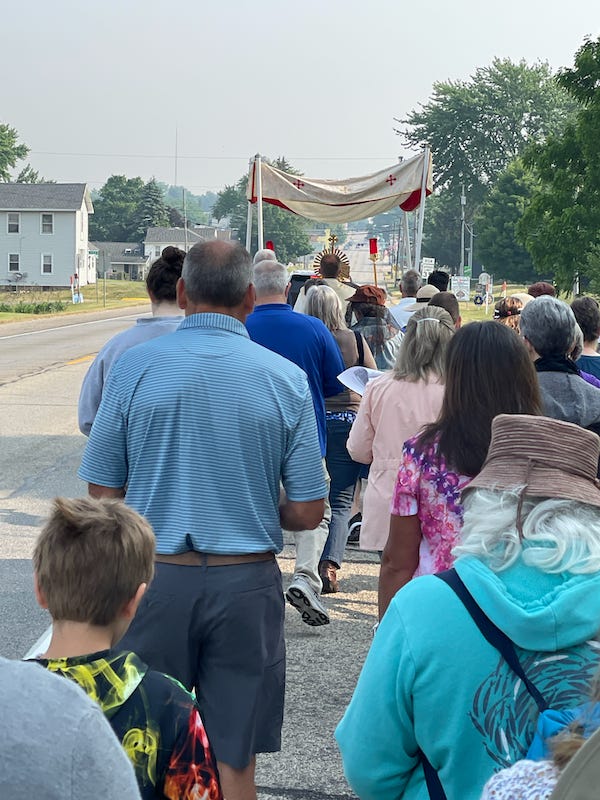
—
If the Eucharistic pilgrimages are for everyone, what are they? What purpose do they serve in the Church’s life?
It turns out, there isn’t just one answer. And that might be a part of the spirituality of pilgrimages.
Some pilgrims and local Catholics in Indiana told The Pillar that they see the pilgrimages as evangelistic opportunities — that the sight of the monstrance might sow seeds of curiosity, which would eventually lead to conversion.
Others said the monstrance might prompt lapsed Catholics to return to confession or the Mass.
Maria Jones of Fort Wayne said she felt the Lord calling her to be a witness through the Eucharistic pilgrimages.
Jones has three children and three grandchildren. She works as a nanny. While the pilgrims walked, Maria left her house each morning to drive to the parish where they’d attend Mass. She goes to Mass with them, walks a mile in the solemn procession, and then drives home.
“That is not for me,” Jones told The Pillar. “I am more worried about people who are falling apart, and falling away — in my own family, and in the world, because they’re my family.”
“I feel Jesus saying: ‘You have to spread the love. You have to spread the fire. The fire I have in you, you have to give it. You have to bring souls to me.’ So this is part of that. People are going to see this, and hopefully, the seed is going to be planted, and they want to come back,” Jones added.
“The Holy Spirit is working right now, and we will see the fruits,” she said. “You will see conversion for people you don’t truly expect. I feel a great awakening is coming. People are blinded and they’re going to be converted. We’re going to see a torrent of conversions.”

Anna Lazier, a youth minister from Fort Wayne, told The Pillar that she’s not sure that many people who see the pilgrimage will have much of a conversion. But she said the witness of Catholics walking with the Eucharist is important.
“It’s an opportunity to express our faith to our community, and to publicly express our faith in a society that doesn’t want us to do this,” said Lazier, 23, who walked nearly eight miles with the pilgrimage on June 7.
“We live in a secular society that is very against religion. Expressions of faith in our culture are seen as oppressive or bigoted. We don’t want this to be a sign of oppression — we want it to express that what we believe in is love, and we believe that God is love, and we believe that he came, and he is in the body and blood, and that is why we process with him,” she added.
“Probably a lot of people driving by might think: ‘What are those weirdos doing? They must be in a cult or something.’ But even if you think, ‘Man, that’s weird,’ you can still acknowledge that they have a great faith in what they’re doing,” she added.
“It gives us a chance to say: ‘This is what we believe in and this is who we believe in, and this is who we’re doing it all in.’”
—
Susan — a parishioner at Blessed Sacrament in Albion, Indiana who declined to use her surname — walked more than seven miles with the pilgrimage on June 7.
She said she was moved by the presence of the Blessed Sacrament processing through her hometown.
“We’ve passed today the homes of the people who came to my mom and dad’s hospital beds. So you’re just asking blessings on real people who you know — I just love this community, and to have the graces that come from this Eucharistic procession flowing into the community that I love — it’s just overwhelming at times.”
“I was moved to tears. I was not expecting that.”
Susan said that she expects the fruit of the procession to be mostly spiritual — and that it might take to germinate.
“This is grace being poured out, and I hope that people in our community will have their eyes opened, to know how much our Lord loves them — and even the blessing of knowing the Eucharistic presence of the Lord.”
“I’m just not going to limit what the blessing could be. Grace is just being poured out.”
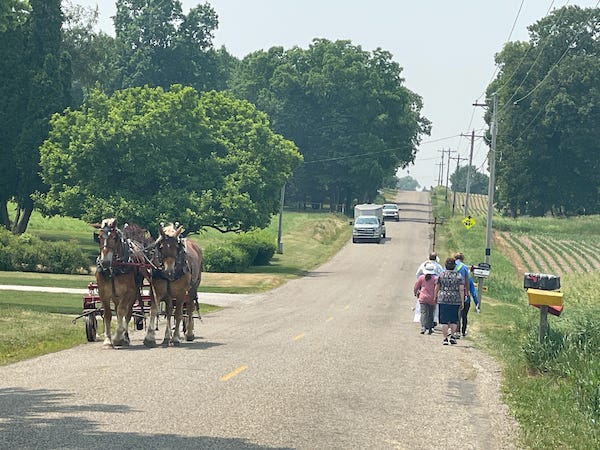
—
For Riza Crump, 46, from Columbus City, Indiana, gratitude is the reason to walk.
Crump, who grew up in the Philippines, walked all 14 miles with the pilgrimage June 7.
“It’s the least I can do for Jesus,” Crump told The Pillar. “The first thing that came to my heart is thanksgiving. We thank the Lord because he does everything. I feel so blessed in our faith.”
Still, Crump said the walk wasn’t just gratitude. She was also offering her own journey as a kind of spiritual reparation.
“I think about offenses against the Blessed Lord, and our Blessed Mother — offenses against the faith being committed, and I thought it’s the least I can do.”
And Crump said she was glad to be able to spend a day in adoration, especially walking in the presence of the Eucharist.
“Who else is better company than Jesus. Who else? What better way can we spend our time than with the Lord Jesus, who is the light, and the source of everything?”
“I just hope I can make it all the way,” Crump added.
She did.
—
Peterson told The Pillar he was not surprised that pilgrims had different reasons for walking along with Blessed Sacrament, or that they expected different fruits.
He said that’s often the way God works in the lives of pilgrims. And for Peterson, the most important fruit of the pilgrimage is the way it changes participants — and the way that might have ripple effects across both Church and society.
“We talk about ‘the Emmaus moment.’ Think about the pilgrims on the road to Emmaus. They walked with Christ, they encountered him in the breaking of the bread — their hearts burned within them, and then they ran back the seven miles to Jerusalem, to spread the good news.”
Peterson said he couldn’t put his finger on what the fruit of the Eucharistic pilgrimages might be. But he said he was certain that the pilgrimages would spur people to action in their parishes, and their communities.
He was sure of that.
“It can sound a little cheesy to say things like ‘the end is the beginning,’ but really, if you complete your pilgrimage, you’ve lifted up your intentions through the intercessions of the saints to the Lord, you’ve hopefully encountered Christ in the breaking of the bread — especially in this Eucharistic pilgrimage — and then if you run back, your heart set on fire, as those disciples were, and you are changed, well, you are going to bring that change to your family, and then that change just spreads.”
“So for this pilgrimage, and for next year —- the people hosting pilgrims, the parishes hosting, the people who walk, hopefully it takes you one step deeper in discipleship. I can’t say for certain how that’s going to affect people, and what that might do. But there’s a hope there for a real transformation.”
“It’s simple, but it’s not simplistic. That’s what a pilgrimage is, really.”




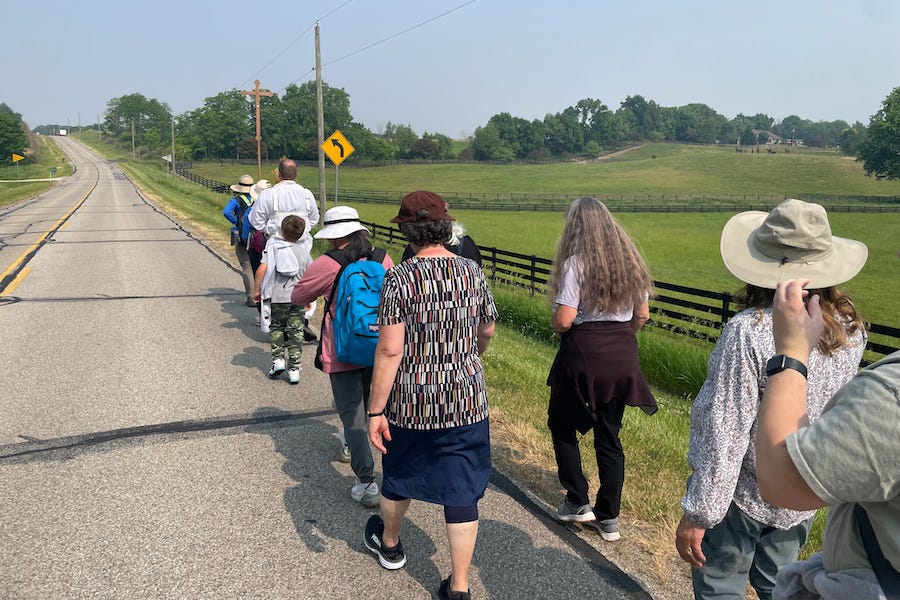
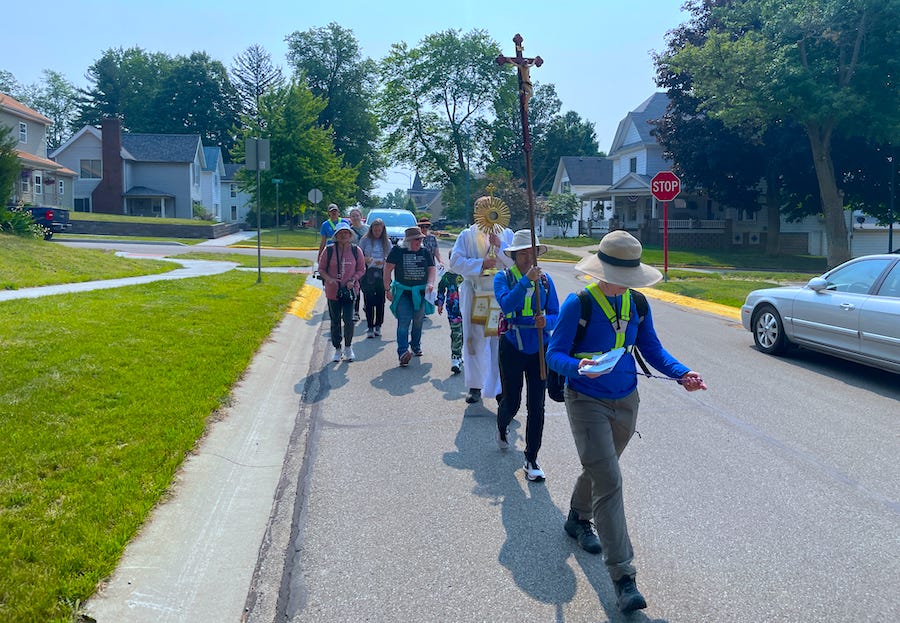
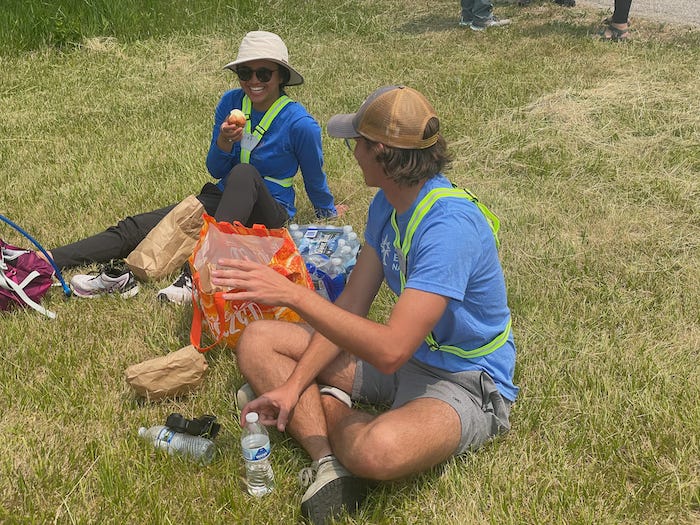

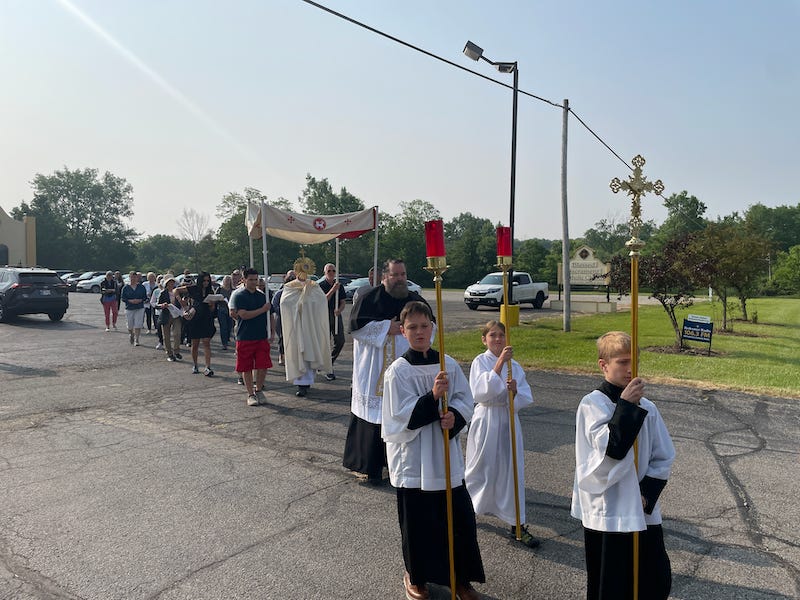
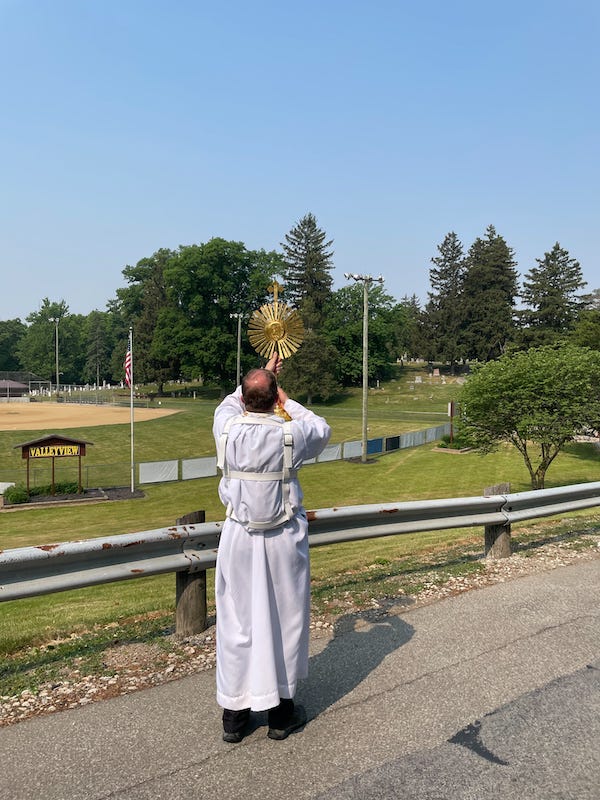






I love when my diocese makes the news for the right reasons. Fantastic folks at Modern Carholic Pilgrim! And I can hear Fr. Felicichia's voice in my head as I read these quotes, and that makes them even better.
Looking at this from a more contemplative angle... this pilgrimage is a prayer. Is prayer only valuable is the recipient of prayer is aware of it? This pilgrimage brings the Eucharistic Presence of Jesus out to His people who do not enter the doors of a Catholic church. Jesus will still be there with them, even if they are blind to it, like the disciples on the road to Emmaus were blind to Him. Let’s let God surprise us!